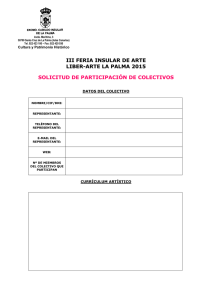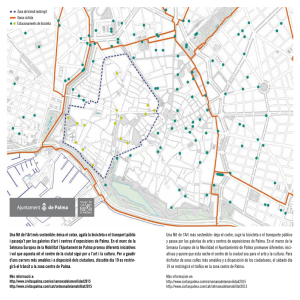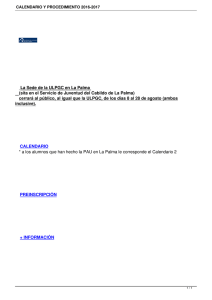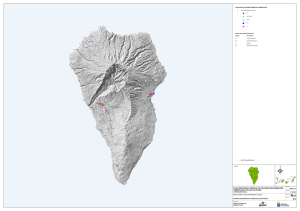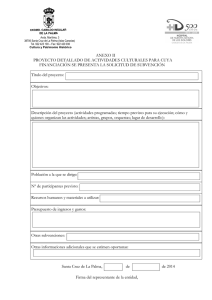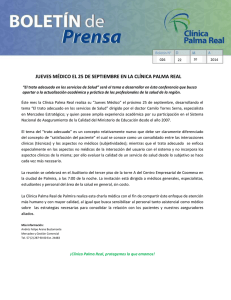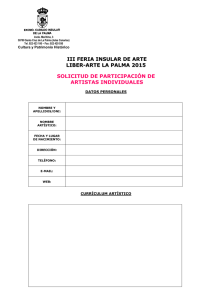septiembre 2016
Anuncio
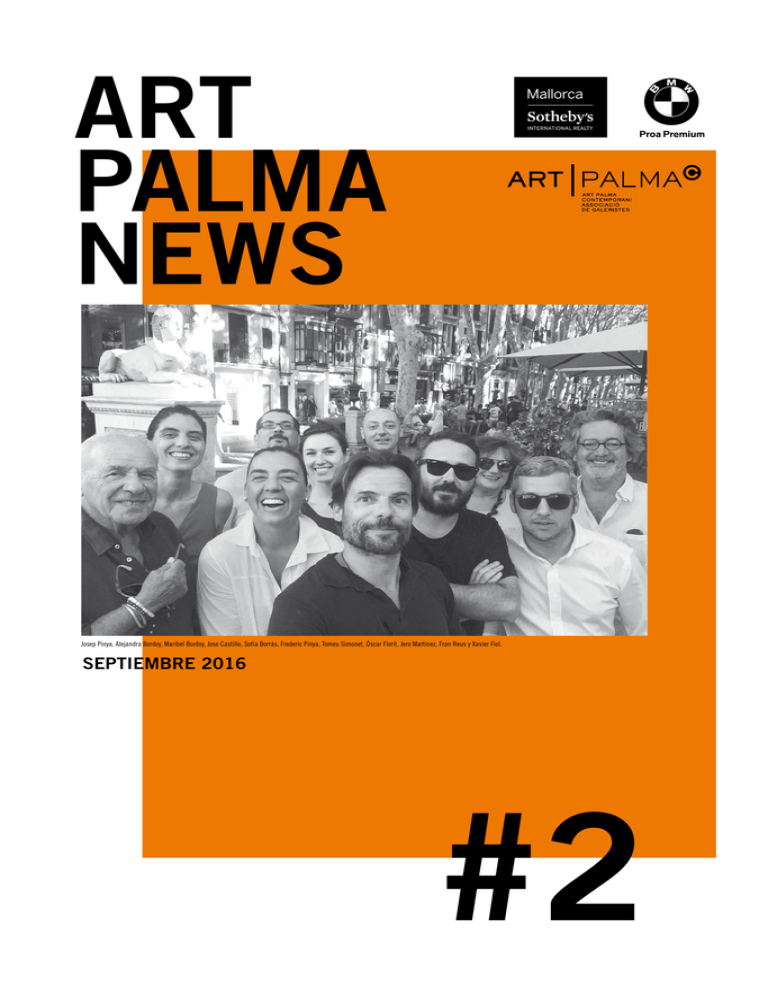
ART PALMA NEWS Josep Pinya, Alejandra Bordoy, Maribel Bordoy, Jose Castillo, Sofía Borrás, Frederic Pinya, Tomeu Simonet, Óscar Florit, Jero Martínez, Fran Reus y Xavier Fiol. SEPTIEMBRE 2016 #2 20 AÑOS DE “NIT DE L’ART” 1997-2016 J Marlene Dumas, Jule-die Vrou, 1985 On a January day in 2004, Jule Kewenig came to Majorca to stay. By then, she had already spent over 30 years working in the art world. The first space Kewenig opened was in Frechen in 1986. Today, the German head office is located at the Museum Island in Berlin, housed in a beautiful 17th-century building in the Mitte neighbourhood. ‘I felt in love with the island and the atmosphere of Palma’s old town’ says Jule, recalling the time her friend jokingly said during one of her stays on the island that he had found the premises for her next gallery. The idea stuck and the gallery on Forn de La Glòria street opened with a show by the great German 2 artist Markus Lüpertz, with whom Jule had shared many experiences and started her career in the art world. It would soon become the small Majorcan base for the Kewenigs. The Oratori de Sant Feliu chapel, it’s current location, is just a stone’s throw from its original home, and opened with an exhibition by Marcelo Viquez. The gallery has hosted shows by many great artists such as Georg Baselitz, who painted a portrait of his friend and gallery owner, christening her with the name Herbert; Jörg Immendorff; Imi Knoebel; Jannis Kounellis; Christian Boltanski; Kimsooja; Sandra Vásquez de la Horra; Pedro Cabrita Reis, KEWENIG BERLIN / PALMA Jule Kewenig llegó a Mallorca para quedarse. Fue un día del mes de enero, exactamente, enero del 2004. Por aquel entonces llevaba ya más de 30 años dedicándose al mundo del arte, y es que el primer espacio que inauguró Kewenig fue en el año 86 en Frechen. A día de hoy la sede alemana se encuentra en La Isla de los Museos en Berlín, en un precioso edificio del siglo XVII en el barrio de Mitte. “I felt in love with the island and the athmosphere of Palma’s old town” afirma Jule, recordando aquellos días en que en una de sus estancias en Mallorca un amigo bromeó diciéndole que tenía el local para su próxima galería. Aquella idea ya no la abandonaría. Aquel local situado en la calle Forn de La Glòria –inaugurado por el artista alemán Markus Lüpertz, prohombre con el que Jule inició sus andanzas en el mundo del arte y compartió años de su vida– se convertiría poco después en la pequeña sede mallorquina de los Kewenig. La actual ubicación en la isla es el Oratori de Sant Feliu, a dos pasos del anterior, este emblemático espacio de la ciudad, inaugurado por Mario Merz, ha sido intervenido posteriormente por otros tantos grandes como Georg Baselitz, quien retratara y bautizara a su amiga y galerista con el nombre de Herbert; Jörg Immendorff; Imi Knoebel; Jannis Kounellis; Christian Boltanski; Kimsooja; Sandra Vásquez de la Horra; Pedro Cabrita Reis, quien inauguró la última edición de Palma Brunch; o Marcelo Víquez, quien presenta su último trabajo en esta edición de la Nit de l’Art. Kewenig pasaría a formar parte de la asociación Art Palma a partir de su segundo año de presencia en Mallorca. Con Pep Pinya a la cabeza de la presidencia, Jule recuerda con cariño aquellas primeras conversaciones en las que planeaban cómo dar solidez al complejo panorama artístico balear. Estos encuentros supondrían para la galería una conexión con el contexto local y nacional del arte contemporáneo. Con la idea de que la unión en el sector privado contribuye a fomentar el crecimiento y, con la intención de contribuir a la construcción de un circuito artístico de calidad en el centro de la ciudad, empiezan a surgir propuestas conjuntas. Se trabaja en el desarrollo de eventos colectivos, la Nit de l’Art, el Palma Brunch y el Palma Photo, a día de hoy redefinido como Palma Summer. Estas tres citas que completan el calendario anual de Ciutat, ponen de manifiesto la inquietud de las galerías palmesanas. Propuestas de indiscutible calidad, han tenido lugar desde la primera Nit de l’Art hace ya 20 años. No cabe duda de que actualmente la ciudad se sitúa en el mapa nacional e internacional de capitales que apuestan por el arte contemporáneo en un formato que abre las puertas a todo tipo de espectador, generando circuito, interés por el arte y en definitiva, generando cultura. Hoy en día, y con el relevo generacional como impulso, el petit Pinya, diez son las galerías que forman Art Palma Contemporani, y diez son las propuestas que ofrece ésta en cada una de las citas. Seguir innovando y mejorando es una prioridad. No hay más que mirar atrás para darse cuenta de que un camino se ha forjado a base de trabajo, esfuerzo y más de un espíritu inquieto y pionero. who opened the last edition of Palma Brunch, and Marcelo Viquez, who will be presenting his latest work at this year’s Nit de l’Art. Kewenig went on to join the Art Palma association in her second year on the island. Jule affectionately recalls those initial conversations with the chair, Pep Pinya, where they planned how to shore up the complex panorama of Balearic art. For the gallery, these meetings offered an opportunity to connect with local and national contemporary art scene. Moved by the conviction that private galleries ought to play a key role in fostering growth within a discerning art circuit from Palma’s city centre, the two galleries joined forces and started to develop a host of high calibre projects. Work began on developing group events, the Nit de l’Art, Palma Brunch and Palma Photo, now reworked as Palma Summer. These three events round out Ciutat’s annual art calendar and underscore the commitment of the galleries in Palma to working together. An uncompromising commitment to high-quality has driven Nit de l’Art since it’s first edition was launched twenty years ago. Today, the city is undoubtedly on the national and international map of destinations reputed for their vibrant art scenes with a clear commitment to developing a circuit open to all audiences, in other words, to fostering and crafting a culture that breeds and celebrates contemporary art practices. Today, under the guidance of the petit Pinya, ten galleries comprise Art Palma Contemporani. Together, they offer ten projects at each event, with innovation and the advancement of artistic production at their heart. The Track record of key events organised by the association throughout its history, is the most eloquent testimony of the clear path forged through hard work, determination and more than one pioneering, restless soul. PROGRAMACIÓN ART PALMA “NIT DE L’ART 2016” ABA ART LAB Pl. de la Porta de Santa Catalina, 21, Palma (www.abaart.com) MERCEDES LAGUENS “LA BRECHA, ARQUITECTURAS DEL TODO Y DE LA NADA” Del 17 de septiembre al 5 de diciembre En esta exposición Laguens investiga la brecha, la escisión, la abertura por donde entra la luz, aquel preciso instante en el que la materia se rompe para dar paso a la luz, a una nueva realidad. Para la artista se trata de brechas abiertas muy prometedoras ya que no es vano sino paso de luz. “La Brecha”. In this exhibition Laguens investigates the gap, the excision, the opening through which light enters, that precise moment in which the material is broken to give way to light. The work explores a new reality, where something needs to break in order to see clearly. For the artist these are very promising breaches, filled with the positivity that new light brings. 3 ADDAYA CENTRE D’ART CONTEMPORANI A PELAIRES CENTRE CULTURAL CONTEMPORANI C. de Can Verí, 3, Palma (www.addaya-art.com) MIGUEL RODRÍGUEZ SEPÚLVEDA “CONCIERTO PARA TRES MACHETES” Días 15, 16 y 17 de septiembre Este video está realizado a partir de la acción sonora desarrollada en el Museo Ex Teresa Arte Actual en Ciudad de México, en la que 3 personas afilaron, durante media hora, un machete, hasta dejar un pedazo de fierro. Cada uno seguía una partitura distinta, 3 palabras diferentes en clave morse. El proyecto gira alrededor de la idea de la imagen del machete como herramienta, pero también como arma y de su proceso de afinación (afilado) excesivo hasta convertirlo en un pedazo de fierro inútil, como alegoría al entumecimiento ante fenómenos sociales en el contexto mexicano. Fotogramas del video “Concierto para tres machetes”. This video has been produced based on the sound action performed at the Ex Teresa Arte Actual Museum in Mexico City where three people sharpened a machete for half an hour, grinding it down to a hunk of iron. Each followed a different score: three different words in Morse code. The project is centred around the idea of the machete as a tool and a weapon, and the excessive tuning (sharpening) process to turn it into a useless piece of metal. This serves as an allegory for the numbness to social phenomena in Mexican society. GALERIA FRAN REUS Paseo de Mallorca 4, bajos derecha, Palma (www.galeriafranreus.net) ANA H. DEL AMO “AÚPA” Del 17 de septiembre al 15 de noviembre El proyecto de Ana H. del Amo, para la galería Fran Reus, consiste en la construcción de piezas de carácter escultórico y geométrico. La técnica que plantea, es la elaboración de sus piezas a través de los “retales” encontrados, de los cuales se apropia. Añadiendo color e incorporando un nuevo elemento, los transforma y nos revela otra manera de observarlos y entenderlos. “S/T”. GALERIA HORRACH MOYÀ Pl. de la Drassana, 15, Palma (www.horrachmoya.com) C. Catalunya, 4, Palma “Gran pintura interrumpida n 5”. 4 Ana H. del Amo’s project for the Fran Reus Gallery comprises constructing sculptural and geometric pieces. The proposed technique aims to produce work with ‘offcuts’ that the artist finds and repurposes. By adding colour and incorporating a new element, the pieces are transformed and reveal another way to appreciate and understand them. SUSY GÓMEZ GIRBENT “ENTR’ACTE” Del 8 de julio al 8 de octubre “PICTURES: LA IMAGEN SENSUAL” Del 17 de setembre al 23 de novembre Esta nueva exposición de genealogía conceptual, surge como oposición al mundo postmoderno del espectáculo, donde el yo y la representación borran los signos de la actividad inconsciente. A partir de ahí explora las narrativas de las formas de vida así como las historias afectivas que trascurren entre los cuerpos. La imagen óptica pintada entendida como singularidad en el contexto actual, en la época de internet y del dominio abrumador de la imagen digital, se constituye en el tema de esta exposición. Lo que se intenta en esta muestra es hacer visible la peculiar complejidad ontológica de la imagen pintada y presentarla como lo que es: la imagen aristocrática por excelencia. This new conceptual genealogy exhibition appears in opposition to the postmodern world of the spectacle, where the self and representation erase the signs of unconscious activity. From here, it explores lifestyle narratives and the emotional stories that take place between bodies. The thrust of this exhibition is painted optical images understood as a singularity in today’s society, the internet age and overwhelming command of digital imagery. This show aims to visualise the peculiar ontological complexity of the painted image and to present it as it is: the aristocratic image par excellence. KEWENIG PALMA Oratori de Sant Feliu. C. de Sant Feliu, s/n, Palma (www.kewenig.com) MARCELO VÍQUEZ “LOS COMUNES” Del 17 septiembre al 19 de noviembre En esta ocasión, Marcelo Víquez, compara el mundo con un gran taller, repleto de herramientas. Todo sirve para algo, incluso lo que parece inútil, pero quizás no para aquello que se nos ha indicado que servía. Armas que no matan ni hieren, banderas que a nada y a nadie representan. “Untitled (Nuestras armas no hacen daño)”. In this exhibition, Marcelo Víquez compares the world to a huge workshop filled with tools. Everything is useful, even what appears not to be, but not necessarily for what we think it is meant. Weapons that do not kill or maim, and flags that represent nothing or no one. L21 GALLERY C. de Sant Martí, 1, bajos, Palma (www.l21gallery.com) C. Gremi Ferrers, 25, Polígono Son Castelló JOAN MOREY IAN WAELDER “LENGUAJE (PRÓLOGO)” Performance de las 20 a las 23h del 17 de septiembre (un único día) “SUEDE” Del 8 de setembre al 10 de desembre Nuevo espacio Polígono Son Castelló La performance LENGUAJE toma como punto de partida la conferencia radiofónica de Michel Foucault “El cuerpo utópico” (1966), en la que Foucault ofrece un análisis del cuerpo que parte del contraste entre la presencia implacable y familiar del cuerpo propio y el cuerpo transformado, el “cuerpo sin cuerpo”, que es el actor principal de todas las utopías. Este trabajo sirve como prólogo de la exposición colectiva de título homónimo que se inaugurará en diciembre en L21. “Il Linguaggio del corpo (Le Fontane – Roma)”. The starting point for the performance LENGUAJE (‘Language’) is Michel Foucault’s radio conference ‘The Utopian Body’ (1966), where Foucault offered an analysis of the body by contrasting the implacable familiar presence of one’s own body to that of the transformed body, the ‘body without body’, which is the main protagonist in all utopias. This work acts as a prologue to the group exhibition of the same name that will open at L21 in December. LA CAJA BLANCA C. de Can Verí, 9, Palma (www.lacajablanca.com) ELNAZ JAVANI “TO CUT A TONGUE THAT HAS NOT BEEN TAMED” En su primera exposición en Palma, podrán ver un ejemplo de la iconografía de Javani, desarrollada intuitivamente, mediante experimentos con hilos, bordados, caligrafía, escritura automática y el textil como metáfora de la mutación de identidades. Su técnica de trabajo, requiere largas horas sentada en posturas que evocan la metódica mecánica de los calígrafos orientales. Detalle de la obra de Elnaz Javani. Her first solo show at the gallery presents a collection of works developed intuitively inspired by threads, embroidery, calligraphy and automatic writing. The artists’ visual iconography woven into textile as a metaphor for mutating identities. Her technique requires long sessions of cross-legged sittings, much like traditional oriental calligraphers. 5 GALERIA MAIOR – PALMA C. de Can Sales, 10, Palma (www.galeriamaior.com) DANIEL VERBIS “DOBLE RÉGIMEN (CUERPO MINERAL Y NUDO VISCERAL)” Del 15 de septiembre al 19 de noviembre Verbis es uno de los pintores españoles con un lenguaje más personal. En su trayectoria, la renovación y la experimentación han marcado su recorrido. A través de un continuo juego con el espacio, su trabajo da lugar a nuevas formas de expresión y a la introducción de nuevos materiales. Para él la característica más radical de la pintura es la ambigüedad. Verbis is a Spanish painter with a highly personal language. Renewal and experimentation have marked his career. His work gives rise to new ways of expression and introduces new materials through a continuous play on space. For the artist, painting’s most radical feature is ambiguity. “El huevo de la serpiente”. PELAIRES CENTRE CULTURAL CONTEMPORANI C. de Can Verí, 3, Palma (www.pelaires.com) “Blue silence”. MARK FRANCIS NICHOLAS WOODS A Mark Francis le entusiasma la ciencia y cómo ésta mira al mundo que nos rodea. Esta exposición tiene el fin de integrar elementos desconectados por lo que podemos y no podemos ver. A través de estas obras conseguimos entender y experimentar visceralmente el universo, no como algo “allí fuera”, sino como un campo infinito del cual formamos parte. En su primera exposición en la Galería Pelaires, Nicholas regresa al gran formato. El título se refiere al “Great American Nude” de Tom Wesselmann (1931-2004), que a su vez se refería a la “Great American Novel”. Nicholas Woods, en esta ocasión, lo utiliza como excusa para explorar una visión autobiográfica del mundo. Mark Francis is fascinated by science and how it views the world surrounding us. This exhibition aims to integrate disconnected elements for what we can and cannot see. The works enable us to understand and viscerally experience the universe, not as something ‘out there’ but rather an infinite field of which we are part. Nicholas returns to large formats in his first exhibition at the Pelaires Gallery. The title references the ‘Great American Nude’ by Tom Wesselmann (1931-2004), who is turn referenced the ‘Great American Novel’. Here, Nicholas Woods uses it as a way to explore an autobiographical vision of the world. “THE EVIDENCE OF ABSENCE” Del 17 de septiembre al 26 de noviembre (planta baixa) “AMERICAN NUDE” Del 9 de junio al 26 de noviembre (planta noble) GALERIA XAVIER FIOL C. de Sant Jaume, 23 A, Palma (www.galeriaxavierfiol.com) PEP LLAMBIAS “REBOST” Del 15 de septiembre al 15 de noviembre Después de presentar en nuestro espacio de proyectos de Madrid el solo show “El peso de la Luz” Pep LLambias se adentra en su nueva exposición en los espacios encerrados, espacios del vacío. Habla de las obsesiones, de los problemas de nuestro tiempo, siempre con un mensaje en forma poética y que se articula con la palabra y con la Luz como protagonista. After presenting his solo show ‘El peso de la Luz’ (‘The Weight of Light’) at our Madrid projects space, Pep LLambias launches his new exhibition in enclosed spaces: spaces of the void. Here, he talks about the obsessions and problems of our era, always with a poetic message expressed through words where Light is the leading role. “Vacío”. 6 1. ABA ART LAB 2. ADDAYA CENTRE D’ART CONTEMPORANI 4 3 3. GALERIA FRAN REUS 4. GALERIA HORRACH MOYÀ 1 8 5. KEWENIG PALMA 6. L21 GALLERY 7. LA CAJA BLANCA 8. GALERIA MAIOR – PALMA 9. PELAIRES C.C.C. 10. GALERIA XAVIER FIOL 1 10 6 8 5 9 2 7 4 ITINERARIO ART PALMA “NIT DE L’ART 2016” 9 OPINIÓN CARLOS URROZ Director de Arco La Nit de l’Art visibiliza la labor de las galerías y centros de arte contemporáneo. Ha creado una cita en el calendario que nos anima a volver a Mallorca para ver las exposiciones de las galerías. Asimismo anima a las galerías a hacer una exposición más relevante dada su visibilidad. Coincide en espíritu con los ARCO Gallery Walk. Palma es un referente en el arte siendo la ciudad española con más galerías, tras Madrid y Barcelona. The Nit de l’Art highlights the work of contemporary art galleries and centres, becoming a must-see on the city’s agenda and encouraging us to head to Majorca to see gallery shows. Thanks to the visibility it offers, it also encourages galleries to offer standout exhibitions. It neatly aligns with the spirit of the ARCO Gallery Walk. Palma is a benchmark in the art world, coming only behind Madrid and Barcelona in terms of gallery spaces. NIT DE L’ART ROSA ESTEVA Directora creativa de Cortana La Nit de l’Art es una noche mágica, una ocasión para disfrutar de la cultura. Es un evento que anima a la gente a salir a la calle para celebrar la cultura, se genera un ambiente muy bonito, artístico e internacional. Sin duda la Nit de l’Art ha potenciado el lado cultural e internacional de Palma y es una buena forma de dar a conocer otras facetas menos conocidas de la isla. The Nit de l’Art is a magical night, a chance to delight in culture. The event encourages people to get out onto the streets and celebrate culture. This creates a beautiful, artistic and international atmosphere. Without any doubt, the Nit de l’Art has boosted Palma’s cultural and international bent, and it is a great way to discover the lesser-known facets of the island. JOSÉ MARÍA LAFUENTE Coleccionista Es un evento que las galerías organizan con esfuerzo y dedicación… un acontecimiento cultural de primer orden para Palma. Contribuye a mostrar la labor que los galeristas desempeñan a fin de acercar el arte contemporáneo a los ciudadanos… se ha convertido en el evento cultural más concurrido de la ciudad. Los organizadores han sabido compatibilizar la dimensión social del evento con la finalidad artística y cultural de la Nit. It is an event that galleries organise with effort and dedication... a topflight cultural event for Palma. It helps to show the work gallery owners do to bring contemporary art to the general public. It has become the most popular cultural event in the city. The organisers have managed to combine the event’s social side with the Nit’s artistic and cultural imperative. 10 JOSÉ HILA Alcalde de Palma Veo la Nit de l’Art con ganas de crecer y de conseguir aportarnos cosas interesantes…Palma es una ciudad llena de galerías, y esto indica que hay interés por el arte y por los artistas. Es muy importante que la cultura tenga una presencia destacada en Ciutat, porque nos ayuda a potenciarla a nivel turístico y también, porque nos ayuda en el reto de conseguir una sociedad más culta. I see the Nit de l’Art as wanting to expand and bring us interesting exhibitions... Palma is a city filled with galleries and this means there is an interest in art and in artists. It is very important for culture to play a standout role in Ciutat as it helps us strengthen tourism and meet the challenge of creating a more cultured society. IGNACIO SALAS Presidente de la Demarcación de Mallorca del Col·legi Oficial d’Arquitectes de les Illes Balears Desde el Colegio vemos la Nit de l’Art como un evento sociocultural y una oportunidad de acercar el arte a la sociedad. Se ha transformado en un acto muy mediático, conocido a nivel internacional. El Colegio, con su participación, reivindica el papel de la arquitectura dentro del mundo del arte. La Nit de l’Art ha ayudado a reconocer el centro histórico de Palma y a verla como una ciudad histórica, con valores arquitectónicos y artísticos. Here at the Association we see the Nit de l’Art as a sociocultural event and a chance to bring art closer to society. It has become a high-profile event, known around the world. The Association’s participation advocates for the role of architecture within art. The Nit de l’Art has helped to highlight Palma’s old town as a historical city with architectural and artistic values. MIGUEL CONDE Propietario del grupo IT Mallorca Unique Spaces Es la noche más especial de Palma, porque toda la ciudad se vuelca en este evento. La Nit de l’Art ha sido una de las piezas clave para cambiar el centro histórico de Palma, provocando la llegada de un turismo de calidad. Esta cita se está convirtiendo en un referente gracias a la calidad de las propuestas de las galerías de Palma, que premian a la ciudad con este evento. This is Palma’s special night because the entire city comes out to support the event. The Nit de l’Art has been key to the changes seen in Palma old town, leading to an influx of high-quality tourism. The event is becoming a benchmark thanks to the quality exhibitions offered by the galleries in Palma, who truly reward the city with this event. RAMÓN ANDREU Propietario Grupo Tast Desde el principio, es una de las noches más fuertes del año, porque hay mucha gente…un público fantástico para nosotros…es un evento consolidado que funciona muy bien. El arte es una excusa para salir a la calle e ir al restaurante…nos interesa que Palma sea una ciudad viva. Ojalá hubiera muchas Nit de l‘Art. Since the beginning it has been one of the standout nights of the year since so many people come out to enjoy it. This is a fantastic public for us and a strong event that works well. Art is a reason to come out and go to a restaurant; we want Palma to be a living city. I wish there were more Nit de l’Art events. RICARDO GIMENO Editor Ejecutivo Spend In Magazine La Nit de l’Art es una pieza fundamental en el conjunto de iniciativas que hacen que Palma sea actualmente uno de los centros artísticos por excelencia del Mediterráneo. The Nit de l’Art is an essential part of the initiatives that currently place Palma as one of the top artistic centres in the Mediterranean. BMW i3: cero emisiones de CO2 durante su uso. BMW i3 con REX: consumo 0,6 l/100 km. Emisiones de CO2 13 g/km. MÁS AUTONOMÍA QUE NUNCA El nuevo BMW i3 tiene ahora hasta 300 km de autonomía 100% eléctrica**. Y además, si eliges el BMW i3 REX, puedes aumentar la autonomía eléctrica gracias a un pequeño motor de combustión que mantiene el nivel de carga de la batería. BMW Proa Premium Gran Vía Asima, 19 07009 Palma de Mallorca Tel. 971 10 82 82 red.bmw.es/proapremium Nuevo BMW i3. 100% ELÉCTRICO. AHORA, CON 300 KM DE POSIBILIDADES. Desde 190€/mes. *En 47 cuotas. Entrada: 12.830,59€. Última cuota: 16.705€. TAE 5,06% P.V.P. Península y Baleares para vehículos BMW I3 94ah. PVP 34. 643€ (transporte, descuento e impuestos incluidos). Gastos de matriculación y pre-entrega no incluidos. Comisión de formalización: 0€. Importe a financiar: 21.812,41€. Precio total a plazos 38.465,59€. Importe total adeudado: 25.635€. TIN: 4,95%. Valor futuro garantizado 16.515€ (48 meses y 40.000 km). A los 4 años, podrás devolverlo (según condiciones de contrato), cambiarlo o quedártelo pagando la cuota final. Condiciones válidas para pedidos generados hasta 30 de septiembre 2016, Financiación ofrecida por BMW Bank GmbH, S.E. Modelo visualizado no coincide con modelo ofertado. **Autonomía de 300 km determinada en ciclo NEDC. Las posibles ventajas fiscales o de circulación aplicables a vehículos eléctricos pueden variar en función del territorio. BMW i3: cero emisiones de CO2 durante su uso. BMW i3 con REX: consumo 0,6 l/100 km. Emisiones de CO2 13 g/km. COLECCIONISMO ENTREVISTA AL SR. JAIME SORDO Y AL SR. CARLOS ROSÓN, CON MOTIVO DE LA CHARLA QUE VAN A IMPARTIR EL PRÓXIMO 15 DE SEPTIEMBRE EN LOS JARDINES DE LA MISERICORDIA, GRACIAS A LA COLABORACIÓN DEL DEPARTAMENT DE CULTURA, PATRIMONI I ESPORTS DEL CONSELL DE MALLORCA, EN EL MARCO DE LA CELEBRACIÓN DE LA XX NIT DE L’ART. C ¿CÓMO EMPEZASTE A COLECCIONAR? Y ¿QUÉ COLECCIONAS? JS Inicio las compras en 1976, es decir, ya llevo cuarenta años cerca del arte contemporáneo, tanto nacional como internacional. La denominación Colección Los Bragales, como tal, aparece en 2005. Habitualmente, la mayoría de las colecciones son eclécticas, tienen un componente generacional y van unidas al contexto del mercado en el que surgen. En mi caso, el inicio de la colección va ligado a mi entorno cántabro, a galerías que exponían artistas de las denominadas Escuela de París, la de Madrid y el Informalismo. Lógicamente, la colección va creciendo en torno a estas obras. Me ocurre, como a la mayoría de los coleccionistas, que me he ido adaptando a los cambios y al arte de nuestro tiempo. Así, Los Bragales va incorporando pintura de los años 80, 90… pero también introduce la fotografía, el video y la instalación, lenguajes imprescindibles hoy en día. Mi colección crece y se desarrolla, según mi capacidad de inversión, siguiendo un poco las diferentes “tendencias” de estos años. Además, asisto de manera regular a ferias como ARCO, Basel, Frieze, FIAC, entre otras y 12 acudo a inauguraciones de galerías y museos. Completo esta aproximación al arte con la lectura profesional, de prensa especializada y textos de catálogos. CR Cuando estudiaba la carrera en Madrid me iba todos los sábados a ver exposiciones. En esa época era un mero espectador, pero creo que ahí se fue gestando mi pasión por el arte. Después, con mis primeros ahorros empecé a comprar alguna obra, pero lo que realmente me hizo pensar en coleccionar fue la visita a una exposición de la colección Arte Contemporáneo, que ahora está depositada en el Museo Patio Herreriano de Valladolid. Cuando la vi me dije, <<esto es lo que yo quiero hacer>> y, en la medida de mis posibilidades, empecé a coleccionar lo que en ese momento era más próximo a nosotros, el arte español y en dos soportes fundamentalmente, pintura y escultura. Inicié mi colección en 1993, y fui adquiriendo obras hasta finales de los 90. También debo decir que entendí que toda colección debe tener un origen y ese fue, en mi caso, el Informalismo, ya que considero que marcó un punto y aparte en el arte español. Así, incorporamos a la colección obras de artistas del grupo El Paso y de Tàpies, entre otros, además de las obras que en ese momento se estaban produciendo. 1998 es un año decisivo para entender mi colección: entro a formar parte del Patronato del Centro Galego de Arte Contemporánea y, por ese motivo empiezo a viajar, a salir fuera, a ir a ferias y a bienales y me doy cuenta que no tiene sentido tener una colección exclusivamente de arte español. A partir de esa fecha, empezamos a introducir artistas internacionales en nuestra colección y, además, ampliamos los soportes y técnicas que compramos: fotografía, instalaciones y en menor medida, el video. ¿QUÉ ES 9915? JS Es el nombre de la Asociación de Coleccionistas Privados de España. Nos unimos como grupo e iniciamos la actividad en febrero de 2012, con 10 socios fundadores. En la actualidad somos 62 socios numerarios (coleccionistas privados), 5 socios protectores que nos aportan servicios y 6 socios colaboradores: Fundación Banco Santander, Centro de Arte Alcobendas, Seguros médicos DKV, Fundación Cerezales Antonino y Cinia, Museo ABC y Fundación Vivanco. Nuestro principal objetivo es trabajar en la información y formación de los coleccio- nistas. En este sentido, cabe destacar que este verano hemos realizado el 4º Curso sobre coleccionismo en la UIMP (Universidad Internacional Menéndez Pelayo) de Santander, dedicado al mercado. En años anteriores, se han tratado temas como el mecenazgo y la relación con los comisarios y artistas. CR Mi incorporación a 9915 fue gracias a Jaime. Lo conocí un día en Gijón, en unas conversaciones sobre arte en las que él participaba. Me habló de que en el sector del arte había asociaciones profesionales de galeristas, de artistas, de gestores culturales, de comisarios, de directores de museos, pero faltaba que una de las patas fundamentales, sobre las que se sustenta el sector artístico, que somos los coleccionistas, nos uniésemos. Así lo hicimos y creo que hoy somos una Asociación de referencia en el ámbito español, que estamos creciendo y facilitando la incorporación de nuevas personas al mundo del coleccionismo. CARLOS POR QUÉ CREASTE UNA FUNDACIÓN CR Para un coleccionista, al menos en nuestro caso, adquirir obras está muy bien, pero llega un momento en que te interesa hacer algo más. Te apetece conocer a los artistas, convivir con ellos, ver cómo es su proceso creativo, aprender de ellos y finalmente, si es posible, colaborar en ese proceso creativo con ayudas a la producción. Para ello, en el año 2007 decidimos crear una Fundación y pensamos que lo ideal era desarrollar un programa de residencias de artistas. Así lo hicimos y desde ese primer año hemos invitado, de manera regular, a un artista internacional a venir a Galicia y a desarrollar un proyecto específico para nosotros, basado en su experiencia en el lugar. Creo que el territorio, su cultura, su paisaje, debe marcar un tipo determinado de proyectos. Sin embargo, también teníamos otro objetivo cuando pensamos en hacer una Fundación: poner a disposición de las personas las obras que teníamos. Pontevedra, donde está la sede de la Fundación, es una ciudad con una importante Facultad de Bellas Artes. Queríamos que sus alumnos pudiesen ver, en su propia ciudad, esas obras y hacerlo extensivo al resto de la ciudadanía. Se trataba de facilitar el conocimiento del arte, en la medida de nuestras posibilidades. ¿LA COLECCIÓN SE HACE DESDE EL CONO- CIMIENTO O DESDE LA SENSIBILIDAD? CR Bueno, yo creo que ambas cuestiones van unidas cuando hablamos de coleccionismo y no se pueden desvincular la una de la otra. El conocimiento es fundamental. Cuando me preguntan qué consejo le daría a un nuevo coleccionista, siempre digo que ver, ver y ver. Hay que pisar muchas galerías, museos, bienales, ferias. Conocer es fundamental para hacer una colección, pero por supuesto, tan importante como ver es dejarse llevar por lo que a uno le gusta, por aquella obra que te ha emocionado, que te dice algo, que no se te va de la cabeza. ¿CÓMO DEFINES AL COLECCIONISTA? JS Creo que la mejor forma de redefinir al coleccionista, como decía Michael Findlay en su libro El valor del Arte, es que a todos los coleccionistas se les identifica por tres conceptos: -Un verdadero amor al arte. Pasión. -Un seguimiento de la inversión, más desde la evolución del trabajo de los artistas por los que se ha apostado que por la revalorización de la obras. -Y, por último, por creer en el valor esencial de arte, enfatizado por el componente social del mismo, plasmado en la generosidad y apertura de las obras de la colección, cuando los profesionales del sector las demandan. Carlos Rosón Jaime Sordo Jaime Sordo González Propietario de la Colección Los Bragales. Presidente de la Asociación de Coleccionistas Privados de Arte Contemporáneo 9915. Premio RAC al coleccionista del año 2013 por el IAC (Instituto de Arte Contemporáneo). Carlos Rosón Gasalla Presidente de la Fundación Rac (Rosón Arte Contemporáneo) que tiene como objetivos la difusión del arte contemporáneo y el mecenazgo de artistas. Miembro de la Junta Directiva de la Asociación de Coleccionistas Privados de Arte Contemporáneo 9915. ¿QUÉ PAPEL JUEGA EL COLECCIONISTA PRIVADO EN EL ARTE CONTEMPORÁNEO? JS Siempre ha sido importante el coleccionismo privado en el arte contemporáneo, frente a lo institucional y corporativo, pero es verdad que a partir del 2008 en España con el inicio de la crisis (en la que aún estamos sumergidos) y dado el parón de las inversiones tanto de lo público como lo empresarial, es el coleccionismo privado el que está manteniendo el mercado, con niveles equivalentes a los 300 millones en el 2014, en compras tanto en galerías, como en subastas y mercado secundario. CR Creo que el papel del coleccionista es cada vez mayor. Pienso que hay que ir hacia un perfil de coleccionista tipo americano o centroeuropeo, que apoyan con sus colecciones a los museos y a las instituciones. El sector público tiene cada vez menos recursos económicos y el coleccionista privado puede y debe colaborar con la incorporación de sus colecciones. No queremos sustituir a los directores de los museos, sino colaborar con ellos, trabajar conjuntamente y dar una mayor visibilidad a nuestro patrimonio cultural ¿POR QUÉ HAY MENOR NÚMERO DE COLECCIONISTAS ESPAÑOLES TENIENDO EN CUENTA LA RIQUEZA DE NUESTRO PATRIMONIO? ¿ES UNA CUESTIÓN MERAMENTE ECONÓMICA O TAMBIÉN CULTURAL? JS Es cierto que siempre nos quejamos del bajo número de coleccionistas españoles en referencia a otros países europeos o americanos. Para establecer cifras, estamos hablando de un mercado, a nivel mundial, de 51.000 millones de €, de los cuales, Europa es un 30 % y el coleccionismo español del orden de un 0.6% del coleccionismo mundial y un 2% del coleccionismo europeo. Con estas cifras es cierto que la participación del coleccionismo español es muy baja, tanto en Europa como en el mercado mundial, y que existe poca incorporación de nuevos coleccionistas. En este sentido, será necesario generar más educación reglada y más información sobre los circuitos expositivos, por lo que es más una cuestión de dinamización cultural del nuevo coleccionismo, que del propio hecho económico. Respondiendo a la pregunta creo que es una cuestión de formación y de tomar la iniciativa para llevar a cabo acciones que promuevan el coleccionismo. ¿QUÉ OS PARECEN LAS INICIATIVAS DE ART PALMA CONTEMPORANI? JS Las iniciativas de Art Palma Contemporani, con la Nit de l’Art, el Art Palma Brunch y el reciente Art Palma Summer, están encuadradas en lo que antes denominábamos la divulgación del arte contemporáneo en una zona específica como es Palma. Es importante dar a conocer, tanto al sector profesional del coleccionismo, como a futuros nuevos coleccionistas, la oferta del galerismo mallorquín. Estas iniciativas están funcionando también de forma interesante en Madrid, Barcelona y Valencia y por supuesto en otras ciudades europeas. CR Creo que hay que conseguir la máxima difusión y conocimiento del arte y en este sentido, me parecen unas iniciativas muy interesantes. Similares proyectos como la Nit de l’Art existen en otras ciudades con unos resultados magníficos y creo que todo lo que se proponga con esta finalidad es siempre positivo. Pienso que en Mallorca hay muy buenas galerías y muy buenos coleccionistas y que entre todos debemos potenciar este sector. La línea de actuación que Art Palma Contemporani está desarrollando con proyectos como el de la Nit de l’Art, el Art Palma Brunch y el Art Palma Summer es muy interesante. 13 AN INTERVIEW WITH JAIME SORDO AND CARLOS ROSÓN IN ANTICIPATION OF THE TALK THEY WILL BE GIVING ON 15TH SEPTEMBER IN THE GARDENS OF THE MISERICORDIA BUILDING, THANKS TO THE COLLABORATION OF THE DEPARTMENT OF CULTURE, HERITAGE AND SPORT AT THE CONSELL DE MALLORCA ISLAND COUNCIL AS PART OF THE 20TH NIT DE L’ART. H HOW DID YOU BECOME A COLLECTOR? WHAT DO YOU COLLECT? JS I started to buy in 1976, which means I have been involved the national and international art world for forty years. The name Colección Los Bragales itself first appeared in 2005. Usually, most collections are eclectic, with a generational element and links to the market context where they appear. In my case, the start of the collection is linked to my Cantabrian background, to galleries that showed artists from the Paris School, Madrid School and Informalism. The collection grew around these works organically. As is often the case with collectors, my collection has adapted to evolve with time, incorporating examples of current art production. In this sense, Los Bragales includes paintings from the 1980s and 90s, but also photography, video and installations – essential artistic languages today. My collection expands and develops depending on my investment capacity, following the different ‘trends’ from these periods to a certain extent. In addition, I regularly attend art fairs such as ARCO, Basel, Frieze, FIAC and openings at galleries and museums. I complement this approach with 14 professional journals, specialist publications and catalogues. CR When I studied for my degree in Madrid, I would go to see exhibitions every Saturday. I was a mere spectator at that time, but I believe it is when my passion for art took root. Afterwards, I started to buy a few pieces with my first savings, although what really made me think about collecting was a trip to an exhibition of the Contemporary Art collection, now held at the Patio Herreriano Museum in Valladolid. When I saw it, I said to myself ‘this is what I want to do’, and insofar as I could, I started to collect pieces produced by mainly Spanish artists across two media: painting and sculpture. I started my collection in 1993 and kept buying until the end of the decade. I should also say that I understood my entire collection should have a point of departure and, in my case, this was Informalism since I considered it a turning point in Spanish art. In this vein, we added work by artists from El Paso group and by Tàpies, amongst others, as well as other pieces produced at the time. 1998 was a key year for my collection: I joined the Board of Trustees of the Galician Centre for Con- Jaime Sordo González Founder of Los Bragales Collection. Chairman of the Association of Private Contemporary Art Collectors 9915. 2013 RAC award winner for collector of the year from the IAC (Institute of Contemporary Art). Carlos Rosón Gasalla Chairman of the Rac Foundation (Ronsón Arte Contemporáneo) whose aim is to promote contemporary art and patronage of artists. Board Member of the 9915 Association of Private Contemporary Art Collectors. temporary Art and began travelling abroad, going to fairs and biennials, and realised that it made no sense to develop a collection based exclusively on Spanish art. That’s when we started to add international artists to our collection and expanded the media and techniques we bought: photography, installations and, to a lesser extent, video. WHAT IS 9915? JS This is the name of the Private Collectors Association in Spain. We came together as a group and started our activity in February 2012 with 10 founding members. There are currently 62 full members (private collectors), 5 patron members who provide us with services and 6 collaborating partners: Fundación Banco Santander, Centro de Arte Alcobendas, Seguros médicos DKV, Fundación Cerezales Antonino y Cinia, Museo ABC and Fundación Vivanco. Our main aim is to provide information and training for collectors. In this sense, one highlight from this summer is the 4th Course for Art Collectors at the UIMP (Menéndez Pelayo International University) in Santander, focussed on the art market. Previous courses have looked at patronage and relationships with curators and artists. CR I joined 9915 thanks to Jaime. I met him one day in Gijón at an art talk he was participating in. He told me that in the art world there were professional associations for gallery owners, artists, cultural managers, curators and museum directors, but one of the supporting pillars of the sector was missing: collectors. We decided to join forces and I believe we are today a benchmark association in Spain. We are expanding and attracting new people into the world of art collecting. CARLOS, WHY DID YOU SET UP A FOUNDATION? CR For collectors, at least in our case, buying works is all well and good but there comes a time where you want to do more. You want to get to know artists, spend time with them, see what their creative process is like, learn from them and finally, if possible, collaborate in that creative process with support for their production. This is why we decided to set up a foundation in 2007. We thought it would be ideal to set up an artist-in-residence programme. And this is what we did! We have regularly invited an international artist to come to Galicia from the start to develop a specific project for us, based on their experience there. I believe that land, culture and landscape should leave their mark on a certain type of project. Nonetheless, we also had another aim in setting up the foundation: showing the public the artworks we have. The foundation’s home base city, Pontevedra, houses major Faculty of Fine Art. We wanted the students there to see these works in their own city, as well as open the collection up to the general public. It was about providing knowledge on art, as far as we could. IS THE COLLECTION BASED ON KNOWLEDGE OR FEELING? CR Well, I think these go together when we talk about collecting, and one cannot be decoupled from the other. Knowledge is essential. When new collectors ask me for advice, I always say look, look and look again. You have to go to lots of galleries, museums, biennials, fairs... Knowledge is essential for putting a collection together but, of course, following what you like is just as important, going for a work that excites you, that speaks to you and that you just can’t let go off. HOW DO YOU DEFINE A COLLECTOR? JS I think the best way to define collectors, as Michael Findlay says in his book The Value of Art, is that they can all be identified by three concepts: - A real love for art. Passion. - Keeping an eye on their investment, more from how an artist’s work they have committed to develops than from a monetary return on the work. - And, lastly, their belief in the essential value of art, underlined by its social commitment, and embodied by To answer your question, I think it’s about training and seizing the initiative to carry out activities that promote collecting. their generosity in opening up collections to sector professionals when asked. WHAT ROLE DO PRIVATE COLLECTORS PLAY IN CONTEMPORARY ART? JS Private collecting in contemporary art has always been important compared to institutional and corporate collections, although it is true that from the start of the credit crunch in Spain in 2008 (which is still ongoing), and given the halt in public and corporate investments, private collecting is sustaining the market with 300 million euro invested in 2014 through purchases from galleries, auctions and the secondary market. CR I think the role of private collectors in ever more important. I believe we need to move towards a more American or Central European collector profile, where their collections help support museums and institutions. The public sector has ever fewer financial resources and private collectors can and should collaborate by incorporating their collections. We do not want to replace museum directors but rather collaborate and work with them to provide greater visibility to our cultural heritage. WHY ARE THERE FEWER SPANISH COLLECTORS GIVEN OUR RICH CULTURAL HERITAGE? IS IT JUST A QUESTION OF MONEY OR IS THERE A CULTURAL ELEMENT? JS It’s true that we always complain about the low numbers of Spanish collectors compared to other European or American countries. In terms of figures, the global market runs to 51 billion euro with Europe representing around 30% and Spanish collectors around 0.6% of global collections and 2% of European collections. These statistics clearly show that the participation of Spanish collectors is very low, both in Europe and on the global market, and there are few new collectors coming through. In this sense, we need to see more official awareness-raising and more information about exhibition circuits. It is more about cultural revitalisation in new collecting than money. WHAT DO YOU THINK ABOUT THE INITIATIVES AT ART PALMA CONTEMPORANI? JS The initiatives at Art Palma Contemporani such as the Nit de l’Art, Art Palma Brunch and the recent Art Palma Summer are within a framework of what we used to call contemporary art promotion within a specific area, such as Palma. Introducing what Majorcan galleries have to offer the professional collecting sector and future collectors is important. These initiatives are also working well in Madrid, Barcelona and Valencia, and of course in other European cities. CR I think we have to ensure maximum art promotion and knowledge and, in this sense, I think they are highly interesting initiatives. There are similar projects to the Nit de l’Art in other cities that have had marvellous repercussions, and I believe anything that is put forward for this purpose is always a good thing. I think there are very good galleries and collectors in Majorca, and we should all work together to boost the sector. The policy being implemented by Art Palma Contemporani through projects such as the Nit de l’Art, Art Palma Brunch and Art Palma Summer is hugely interesting. 15 L’ORGANITZEN HI COL·LABOREN Departament de Cultura, Patrimoni i Esports Consell de Mallorca
